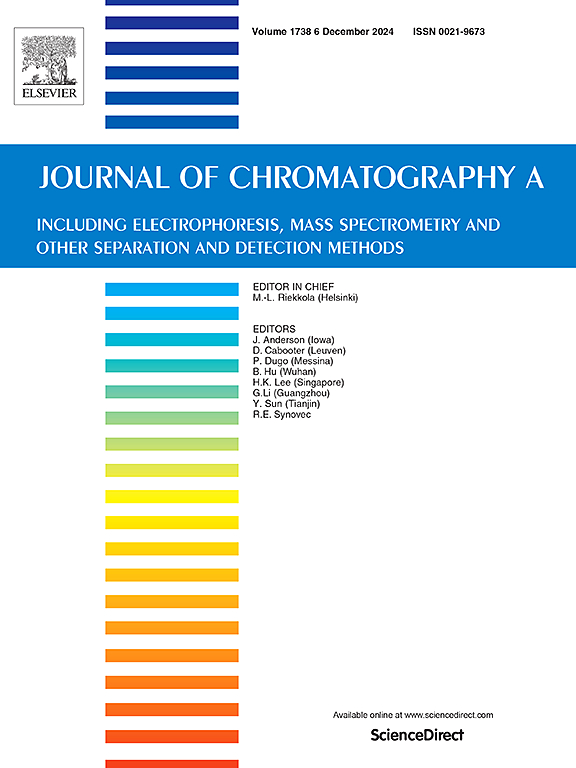co2响应切换深共晶溶剂基均相液-液微萃取法测定水中多氯联苯。
IF 4
2区 化学
Q1 BIOCHEMICAL RESEARCH METHODS
引用次数: 0
摘要
建立了一种基于可切换深度共晶溶剂(SDES-HLLME)的液液均相微萃取技术,结合气相色谱-三重四极杆串联质谱(GC-MS/MS)对水样中16种多氯联苯(PCBs)的提取和分析。以单乙醇胺(MEA)为氢键受体(HBA), 3-甲氧基酚(3-MP)为氢键供体(HBD)组成的co2响应型可切换深度共晶溶剂(SDES)为萃取剂,为传统有毒有机溶剂提供了一种环保的替代品。系统考察了SDES的种类和体积、涡旋持续时间、CO2鼓泡时间、离心速率和离心时间、离子强度等参数对萃取效率的影响。最佳提取条件为:SDES浓度为40.0 μL,旋涡时间为40.0 s, CO2鼓泡时间为2.0 min,盐浓度为5.0% (w/v),离心速率为5000 rpm,离心时间为3.0 min。在此最佳提取条件下,该方法线性范围为0.1 ~ 300 ng·mL-1,检出限(lod)和定量限(loq)分别为0.003 ~ 0.096 ng·mL-1和0.009 ~ 0.321 ng·mL-1,相对标准偏差(RSD)为0.003 ~ 0.096 ng·mL-1。本文章由计算机程序翻译,如有差异,请以英文原文为准。
Determination of polychlorinated biphenyls in water by CO2-responsive switchable deep eutectic solvent based homogeneous liquid-liquid microextraction
A homogeneous liquid-liquid microextraction technique based on switchable deep eutectic solvent (SDES-HLLME), combined with gas chromatography-triple quadrupole tandem mass spectrometry (GC–MS/MS), was developed for the extraction and analysis of 16 polychlorinated biphenyls (PCBs) in water samples. CO2-responsive switchable deep eutectic solvent (SDES), which consists of monoethanolamine (MEA) being used as a hydrogen bond acceptor (HBA) and 3-methoxyphenol (3-MP) being used as a hydrogen bond donor (HBD), was used as the extractant, thus providing an environmentally friendly alternative to conventional toxic organic solvents. The study systematically investigated the effects of various parameters on extraction efficiency, including the type and volume of SDES, vortexing duration, CO2 bubbling time, centrifugation rate and time, ionic strength. Optimal extraction conditions were identified as follows: 40.0 μL of SDES, vortexing for 40.0 s, CO2 bubbling for 2.0 min, 5.0 % (w/v) salt concentration, a centrifugation rate of 5000 rpm, and a centrifugation duration of 3.0 min. Under these optimal conditions, the method exhibited a linear range of 0.1–300 ng·mL−1, with limits of detection (LODs) and quantification (LOQs) ranging from 0.003 to 0.096 ng·mL−1 and 0.009 to 0.321 ng·mL−1, while the relative standard deviation (RSD) <7.98 %. Finally, this method was successfully applied to determine the concentrations of 16 PCBs in various environmental water samples, yielding satisfactory recovery rates. This method provides a green, convenient and accurate new idea in the field of HLLME research.
求助全文
通过发布文献求助,成功后即可免费获取论文全文。
去求助
来源期刊

Journal of Chromatography A
化学-分析化学
CiteScore
7.90
自引率
14.60%
发文量
742
审稿时长
45 days
期刊介绍:
The Journal of Chromatography A provides a forum for the publication of original research and critical reviews on all aspects of fundamental and applied separation science. The scope of the journal includes chromatography and related techniques, electromigration techniques (e.g. electrophoresis, electrochromatography), hyphenated and other multi-dimensional techniques, sample preparation, and detection methods such as mass spectrometry. Contributions consist mainly of research papers dealing with the theory of separation methods, instrumental developments and analytical and preparative applications of general interest.
 求助内容:
求助内容: 应助结果提醒方式:
应助结果提醒方式:


